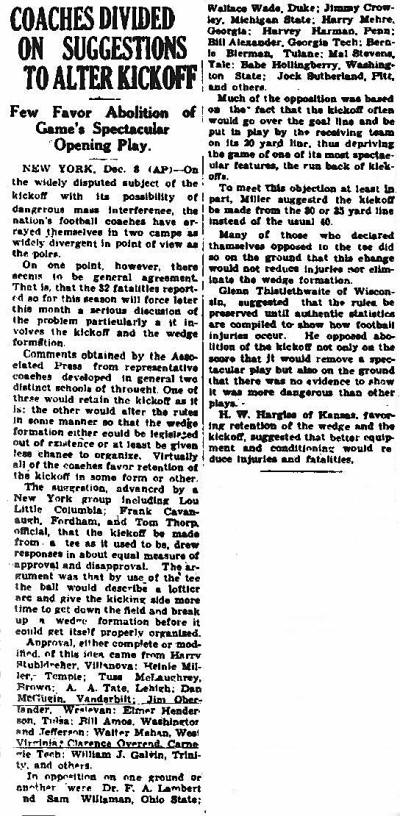|
|
Coaches Divided on
Suggestions to Alter Kickoff
OSWEGO PALLADIUM-TIMES, TUESDAY, DECEMBER 8, 1931
Few Favor Abolition of Game's Spectacular Opening Play.
NEW YORK, Dec. 8 (AP)—On the widely disputed subject of the kickoff with its possibility of dangerous mass interference, the nation's football coaches have arrayed themselves in two camps as widely divergent in point of view as the poles.
On one point, however, there seems to be general agreement. That is, that the 32 fatalities reported so far this season will force later this month a serious discussion of the problem particularly as it involves the kickoff and the wedge formation.
Comments obtained by the Associated Press from representative coaches developed in general two distinct schools of thought. One of these would retain the kickoff as it is. The other would alter the rules in some manner so that the wedge formation either could be legislated out of existence or at least be given less chance to organize. Virtually all of the coaches favor retention of the kickoff in some form or other.
The suggestion, advanced by a New York group including Lou Little Columbia; Frank Cavanaugh, Fordham, and Tom Thorp, official, that the kickoff be made from a tee as it used to be, drew responses in about equal measure of approval and disapproval. The argument was that by use of the tee the ball would describe a loftier arc and give the kicking side more time to get down the field and break up a wedge formation before it could get itself properly organized.
Approval, either complete or modified of this idea, came from Harry Stuhldreher, Villanova; Heinie Miller, Temple; Tuss McLaughry, Brown; A. A. Tate, Lehigh; Dan McGugin, Vanderbilt; Jim Qberlander, Wesleyan; Elmer Henderson, Tulsa; Bill Amos, Washington and Jefferson; Walter Mahan, West Virginia; Clarence Overend, Carnegie Tech; William J. Galvin, Trinity; and others.
In opposition on one ground or another were Dr. F. A. Lambert and Sam Willaman, Ohio State; Wallace Wade, Duke; Jimmy Crowley, Michigan State; Harry Mehre, Georgia; Harvey Harman, Penn; Bill Alexander, Georgia Tech; Bernie Bierman, Tulane; Mal Stevens, Yale; Babe Hollingbery, Washington State; Jock Sutherland, Pitt; and others.
Much of the opposition was based on the fact that the kickoff often would go over the goal line and be put in play by the receiving team on its 20 yard line, thus depriving the game of one of its most spectacular features, the run back of kick-offs.
To meet this objection at least in part, Miller suggested the kickoff be made from the 30 or 35 yard line instead of the usual 40.
Many of those who declared themselves opposed to the tee did so on the ground that this change would not reduce injuries nor eliminate the wedge formation.
Glenn Thistlethwaite of Wisconsin suggested that the rules be preserved until authentic statistics are compiled to show how football injuries occur. He opposed abolition of this kickoff not only on the score that it would remove a spectacular play but also on the ground that there was no evidence to show it was more dangerous than other plays.
H. W. Hargiss of Kansas, favoring retention of the wedge and the kickoff, suggested that better equipment and conditioning would reduce injuries and fatalities.